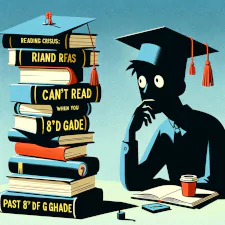Literacy Rate of America
In a nation as advanced and diverse as the United States, one would expect the American literacy rate to mirror its progress. Yet, recent studies paint a different picture, revealing a concerning trend in adult literacy. Current data indicates that the average American adult reads at a level comparable to a 7th to 8th grader, a statistic that raises critical questions about our education system and societal norms. According to a recent study from the Department of Education, roughly half of U.S. adults, aged 16 to 74 years old — 54% or 130 million people — lack literacy proficiency.
Key Take Aways:
- Widespread Literacy Issues: A substantial number of U.S. adults have literacy levels at or below that of an 8th grader, affecting their ability to fully participate in society and the economy.
- Impact on Socioeconomic Status: Low literacy levels correlate with lower income, higher unemployment rates, and greater reliance on social welfare programs.
- Generational and Societal Effects: Low literacy not only limits individual opportunities but also has broader implications for public health, democracy, and economic growth.
What is Literacy?
Literacy is a fundamental skill set that enables individuals to communicate, acquire knowledge, and engage with the world around them. Traditionally, literacy has been primarily understood as the ability to read and write, but its definition has expanded over time to include a broader range of skills and competencies. Key aspects of literacy include:
- Basic Reading and Writing: This involves the ability to decode written language (reading) and the ability to encode thoughts and ideas into language (writing).
- Comprehension: Beyond just reading words, literacy includes understanding and interpreting the meaning of text and spoken language.
- Critical Thinking and Analysis: This aspect of literacy involves the ability to critically evaluate text, discerning underlying meanings, biases, and perspectives.
- Numeracy: Often considered a part of broader literacy, numeracy involves the ability to understand and work with numbers, perform basic arithmetic, and interpret data.
- Digital Literacy: In the modern, digital world, literacy also encompasses the skills needed to effectively navigate and utilize digital technologies, such as the internet, social media, and various software and applications.
- Media Literacy: This includes the ability to critically understand and evaluate media content, including distinguishing between reliable and unreliable sources of information.
- Cultural and Contextual Understanding: Literacy involves understanding the cultural and contextual nuances of language, and recognizing that language can carry different meanings in different settings.
- Functional Literacy: The ability to use reading, writing, and calculation for one’s own and the community’s development. Functional literacy is about applying these skills toward practical ends in everyday life.
- Information Literacy: The ability to locate, evaluate, and use effectively the needed information, which is crucial in the information age.
- Multiliteracies: A recognition of the diverse ways in which communication takes place, including linguistic, visual, audio, spatial, and multimodal forms.
Literacy is more than a simple ability; it’s a crucial tool that empowers individuals to participate effectively in society, achieve personal goals, and develop their knowledge and potential. As society evolves, so does the concept of literacy, adapting to new forms of communication and information exchange.
Table of Contents
- What is Literacy Rate
- How is Functional Illiteracy Best Defined
- Economic Instability
- Social and Health-Related Consequences
- Impact Political Engagement
- Psychological Impact
- Challenges in Addressing Literacy Issues
- Policy and Legislative Challenges
- Technological and Digital Divide
- Educational System Limitations
- Community and Family Engagement
- Research and Best Practices
- Successful Case Studies
- Unite for Literacy
- James Paul Gee What is Literacy
- What is Adult Basic Education?
- Why is Literacy Important?
- What is Cultural Literacy
- Standards of Education
What is Literacy Rate
The literacy rate is a statistical measure that represents the percentage of people within a specified population who can read and write, often with a basic level of comprehension, usually within a certain age range and a specific geographical area.
This metric is commonly used to assess the educational level of a population and is a key indicator in studies of social and economic development. Here are some important aspects to consider about literacy rates:
- Age-Specific Metrics: Literacy rates are often measured within specific age groups, such as adults (typically individuals aged 15 and above) or youth (which may cover ages 15-24), to gauge educational achievement and literacy among different segments of the population.
- Geographical Variations: Literacy rates can vary significantly between different countries, regions, and even within regions of a single country. These variations can reflect differences in educational systems, economic development, and government priorities.
- Gender Disparities: Literacy rates are frequently analyzed by gender, revealing disparities in education and literacy between men and women. In many parts of the world, literacy rates are lower among women due to socio-cultural factors and educational inequalities.
- Basic vs. Functional Literacy: Some assessments differentiate between basic literacy (the ability to read and write simple statements) and functional literacy (the capacity to engage effectively in society and perform activities requiring a certain level of reading and writing).
- Data Collection Methods: Literacy rates are typically gathered through national censuses, surveys, and educational assessments. The accuracy of this data can depend on the methods and definitions used.
- Indicator of Development: The literacy rate is a crucial indicator in development studies, as it is closely linked to other aspects of development, such as economic growth, health outcomes, and social progress.
- Impact of Policies and Programs: Literacy rates can be influenced by governmental and non-governmental educational policies and programs, reflecting the effectiveness of efforts to improve educational access and quality.
Understanding literacy rates provides insight into the educational and developmental status of a population, and it is a critical tool for policy-making, resource allocation, and the planning of educational initiatives.
How is Functional Illiteracy Best Defined
Functional illiteracy is a term used to describe individuals who, despite having basic reading and writing skills, lack the level of literacy necessary to function effectively in everyday situations in a modern society. This concept extends beyond the mere ability to read and write, focusing on the application of these skills in real-life contexts. Here’s a more detailed definition:
- Basic Literacy Skills: Functionally illiterate individuals typically have some basic reading and writing abilities but not at a proficient level. They can read and possibly write simple sentences but struggle with more complex language tasks.
- Inadequate for Daily Requirements: The level of literacy is insufficient for the demands of everyday life and employment. This includes difficulty in understanding and using information from texts, such as newspapers, job applications, instruction manuals, maps, and health information.
- Limited Comprehension: While they might be able to decode words, their comprehension of what they read is often inadequate for understanding and using the information effectively.
- Impact on Employment: Functional illiteracy can limit job opportunities and performance, as many jobs require the ability to read and understand instructions, safety guidelines, or other work-related materials.
- Challenges in Everyday Tasks: Everyday tasks like reading medicine labels, managing finances, filling out forms, following written instructions, or helping children with homework can be challenging for functionally illiterate individuals.
- Social and Economic Consequences: Functional illiteracy can have broad social and economic consequences, including lower income levels, limited access to further education and training, and a higher likelihood of health issues due to the inability to read medical advice or prescription labels.
- Digital Literacy: In the modern digital world, functional illiteracy also encompasses digital literacy, which includes the skills needed to effectively navigate and use digital devices and the internet.
Functional illiteracy is often a hidden issue, as individuals may develop coping mechanisms to conceal their literacy challenges. Addressing functional illiteracy requires targeted educational programs and policies that focus not just on basic reading and writing skills, but also on applying these skills in real-world contexts.
Literacy Statistics in the US

As of 2023, the average reading level in the United States is estimated to be at the 7th to 8th-grade level. This assessment indicates that about half of U.S. adults can’t read a book written at the 8th-grade level. Specifically, 4% of Americans are considered nonliterate, (meaning no written language) having below Level 1 literacy, which means they struggle with basic reading tasks required in modern society. Another 14% of Americans have literacy at a below-basic level (Level 1), and 34% have basic literacy levels (Level 2).
In terms of overall literacy rates, the average score nationwide in the U.S., based on the Program for the International Assessment of Adult Competencies (PIAAC) survey, is 264 out of 500 points.
The states with the highest literacy rates are
- New Hampshire
- Minnesota
- North Dakota
while the states with the lowest literacy rates are
- Florida
- New York
- California
Texas contains 11 counties where greater than 57% of the population is at less than or equal to level 1 literacy. The national literacy rate in the U.S. is approximately 86%, which is lower compared to many other countries globally
These statistics reveal a significant challenge in adult literacy in the U.S., with a considerable portion of the population struggling with reading and comprehension at levels expected for middle school education.
What Adds to the Challenge of Becoming Literate
Becoming literate is a complex process influenced by a variety of factors. Several challenges can impede literacy development in both children and adults. These challenges can be broadly categorized into individual, educational, socio-economic, and cultural factors. Here’s a detailed look at what adds to the challenge of becoming literate:
- Socio-Economic Factors:
- Poverty: Limited access to educational resources, including books and other learning materials, can severely impact literacy development.
- Parental Education and Involvement: Parents with limited literacy skills may be less able to support their children’s learning. Parental involvement is crucial in early literacy development.
- Health and Nutrition: Poor health and malnutrition, especially in early childhood, can affect cognitive development and learning ability.
- Educational System Challenges:
- Quality of Education: Inadequate schooling, insufficient or underqualified teachers, and overcrowded classrooms can hinder literacy development.
- Curriculum and Teaching Methods: Curriculums that do not cater to diverse learning styles or fail to engage students can be a barrier.
- Language of Instruction: In multilingual societies, instruction in a language that is not the child’s first language can make learning to read and write more difficult.
- Cultural Factors:
- Cultural Attitudes towards Education: In some cultures, education may not be prioritized, or there may be gender biases against educating certain groups, like girls.
- Access to Culturally Relevant Materials: A lack of reading materials that reflect a child’s cultural background or language can reduce engagement and interest in reading.
- Individual Challenges:
- Learning Disabilities: Conditions such as dyslexia can make learning to read and write more challenging without specialized instruction.
- Developmental Delays: Early developmental delays in speech, language, or cognitive skills can impact literacy development.
- Motivation and Engagement: A lack of motivation or engagement with reading and writing can stem from various factors, including a lack of role models or exposure to reading in the home environment.
- Technological and Media Influence:
- Screen Time: Excessive screen time can reduce time spent on reading and may impact attention spans and deep reading skills.
- Digital Divide: Limited access to digital technologies can hinder the development of digital literacy skills, increasingly important in modern society.
- Political and Economic Instability:
- Conflict and Displacement: Children and adults in conflict zones or those who are refugees often miss out on consistent education, impacting literacy development.
- Economic Instability: In times of economic hardship, education might take a backseat to immediate survival needs.
Addressing these challenges requires multifaceted strategies, including improving education systems, ensuring access to diverse and relevant learning materials, supporting learners with special needs, and addressing broader socio-economic issues.
Economic Instability

- Workforce Limitations: Low literacy levels restrict individuals’ job opportunities, confining them to lower-paying jobs and reducing overall workforce productivity. This limitation impacts the economy, as a less literate workforce can hinder economic growth and innovation.
- Increased Unemployment Rates: Individuals with low literacy skills often face higher unemployment rates, contributing to broader economic challenges, including increased welfare dependency.
A Study Published by Gallop in September 2020
JONATHAN ROTHWELL, PH.D.
Principal Economist, Gallup
Nonresident Senior Fellow, Brookings Institution, Metropolitan Policy Program
Correlates income to Literacy levels among other findings.
| Mean annual income 2020 USD | Levels 0-1 | Level 2 | Level 3 | Level 4 |
|---|---|---|---|---|
| $34,127 | X | |||
| $47,596 | X | |||
| $62,997 | X | |||
| $73,284 | X | |||
Source: 2012-2017 PIAAC U.S. State and County Estimates for Population; 2017 PIAAC for Income
Social and Health-Related Consequences
- Healthcare Challenges: Low literacy can lead to difficulties in understanding health-related information, resulting in poorer health outcomes and higher healthcare costs. It’s often linked to lower health literacy, which impairs the ability to make informed health decisions.
- Social Exclusion: Low literacy can lead to social exclusion, as individuals may struggle with daily tasks like reading public transport schedules, managing finances, or helping their children with schoolwork.
- Generational Impact: There is often a cyclical effect, where children of parents with low literacy levels are more likely to experience literacy challenges themselves, perpetuating a cycle of educational disadvantage.
Crime and Legal System

- Higher Incarceration Rates: Studies have shown a correlation between low literacy levels and higher rates of incarceration. Individuals with lower literacy skills are more likely to engage in criminal activities, partly due to limited lawful employment opportunities.
- Legal Misunderstandings: Low literacy can lead to misunderstandings of legal rights and obligations, potentially increasing the likelihood of legal issues and difficulties navigating the judicial system.
Civic Participation and Democracy
- Reduced Civic Engagement: Individuals with lower literacy levels are often less involved in civic activities, such as voting or community participation. This reduced engagement can impact the democratic process and lead to a less informed electorate.
- Challenges in Accessing Information: Low literacy levels can impede the ability to access, understand, and critically evaluate political information, which is essential for informed decision-making in a democratic society.
Impact Political Engagement
Low literacy levels significantly impact political engagement and understanding. ProPublica’s analysis reveals a clear correlation between literacy rates and voter participation: as literacy rates in a county decline, voter turnout tends to decrease. This trend was consistent across the election years 2016, 2018, and 2020.
Areas with lower literacy levels often see lower voter turnout, indicating that literacy may act as a proxy for other factors influencing participation, such as income levels or social capital. While literacy itself may directly impact voter participation, various barriers, including socio-economic factors, could also play a role. This pattern underscores the importance of literacy not just in personal development but also in civic engagement and the democratic process (source: ProPublica).
Psychological Impact
- Lower Self-Esteem and Confidence: Individuals with low literacy skills may experience lower self-esteem and confidence, impacting their social interactions and willingness to participate in community activities.
- Stress and Mental Health Issues: The challenges and limitations imposed by low literacy can lead to increased stress and other mental health issues.
Challenges in Addressing Literacy Issues
Diversity of Learner Needs
- Varied Learning Styles and Backgrounds: One of the major challenges in addressing literacy issues is the diversity of learners. People come from different educational, cultural, and linguistic backgrounds, requiring tailored approaches to literacy education.
- Adult Learners: Adult learners often face unique challenges, such as balancing education with work and family responsibilities, and may have different motivations and learning styles compared to younger learners.
Stigma and Motivational Barriers
- Stigma Surrounding Illiteracy: Many adults with low literacy skills feel a sense of shame or embarrassment, which can be a significant barrier to seeking help.
- Lack of Awareness and Motivation: Some individuals may not be aware of their literacy needs or may not be motivated to improve their skills due to past negative educational experiences.
Funding and Resource Allocation
- Inadequate Funding for Literacy Programs: Often, literacy programs, especially for adults, suffer from inadequate funding, limiting their reach and effectiveness.
- Resource Allocation in Education: Funding in education is not always allocated efficiently or equitably, with some areas receiving more resources than others, contributing to disparities in literacy levels.
Policy and Legislative Challenges
- Lack of Comprehensive Literacy Policies: There is a need for more comprehensive, cohesive policies that address literacy across all age groups and backgrounds.
- Challenges in Implementing Policies: Even when policies are in place, the implementation can be challenging due to bureaucratic hurdles, lack of coordination among various stakeholders, and inconsistencies in enforcement.
Technological and Digital Divide
- Rapid Technological Changes: The fast pace of technological change can make it difficult for literacy programs to keep up, especially for older adults or those in low-income communities.
- Digital Divide: There is a digital divide where some populations have limited access to digital resources, which are increasingly important for literacy development in the modern world.
Educational System Limitations
- One-Size-Fits-All Approach: The tendency towards a uniform educational approach does not address the diverse needs and challenges of different learners.
- Early Identification and Intervention: There is a challenge in identifying and supporting children with literacy difficulties early in their education, which is crucial for preventing long-term literacy issues.
Community and Family Engagement
- Engaging Families and Communities: Effective literacy development often requires the involvement of families and communities, but engaging them effectively can be challenging.
- Cultural and Language Barriers: In multicultural and multilingual societies, language and cultural barriers can impede the effectiveness of literacy programs.
Research and Best Practices
- Need for Ongoing Research: Understanding the most effective literacy practices requires ongoing research, which can be limited by funding and resource constraints.
- Dissemination and Implementation of Best Practices: Even when research identifies effective strategies, disseminating and implementing these practices across various educational settings can be challenging.
Addressing these challenges requires a multifaceted approach that includes policy changes, increased funding, community engagement, and tailored educational strategies to meet the diverse needs of learners. It’s a complex issue that calls for collaboration among educators, policymakers, community leaders, and learners themselves.
Successful Case Studies

Two successful literacy programs, from Morningside Elementary School and Riverside Elementary School, showcase effective strategies for addressing literacy challenges:
- Morningside Elementary School’s Approach to Dyslexia
- Morningside Elementary, not your typical urban school, has implemented a comprehensive literacy program, especially for students with dyslexia.
- The key elements of their approach include:
- Intensive Teacher Training: Every teacher and administrator undergoes a 70-hour training course covering early literacy, phonics, word roots, and learning disabilities, with a focus on dyslexia.
- Diverse Teaching Tools: A variety of teaching methods and tools, like Wilson Fundations Phonics and a balanced literacy approach, are used to cater to different learning styles.
- Monitoring Student Progress: The school consistently monitors the progress of students, especially those struggling with reading, to tailor their learning experiences effectively.
- Riverside Elementary School’s Literacy Improvement
- Riverside Elementary School underwent strategic changes to improve literacy instruction.
- Key aspects of Riverside’s success include:
- Strategic Programmatic Changes: Implementing research-based changes led to significant improvements in student reading achievement.
- Data-Driven Approach: The school tracked progress through Third Grade English Language Arts Proficiency data, which showed substantial improvement from 50% in 2016 to 91% in 2019.
- Comprehensive Case Study Analysis: The success story of Riverside Elementary was documented through interviews with educators and parents, providing insights into effective literacy strategies.
Both case studies demonstrate the importance of dedicated teacher training, diversified teaching methods, continuous monitoring and assessment of students, and strategic programmatic changes. These examples provide valuable insights into how different approaches can be effectively implemented in public school settings to enhance literacy skills among students.
Unite for Literacy
“Unite for Literacy” is an initiative or concept that typically represents efforts to address literacy challenges and promote reading skills, especially among children. The aim of such initiatives is often to bring together various stakeholders — like educators, parents, community organizations, and policymakers — to create a supportive environment for literacy development. Key aspects of “Unite for Literacy” may include:
- Promoting Access to Books: Ensuring children have access to a wide range of reading materials, including digital books and books in multiple languages.
- Community Engagement: Involving local communities in literacy promotion through events, reading programs, and awareness campaigns.
- Education and Training: Providing teachers and parents with the tools and training necessary to support children’s literacy development.
- Early Childhood Education: Emphasizing the importance of early literacy skills from a young age.
- Diverse Literature: Offering books that represent diverse cultures, languages, and experiences to engage a broad spectrum of young readers.
- Public-Private Partnerships: Collaborating with private entities, non-profits, and government agencies to pool resources and expertise.
- Research and Advocacy: Conduct research to understand literacy challenges and advocate for policies that support literacy education.
- Technology and Innovation: Using technology to improve access to reading materials and literacy education, especially in underserved areas.
- Inclusivity in Literacy: Ensuring that literacy programs are inclusive and cater to the needs of all children, including those with disabilities or those from various socio-economic backgrounds.
- Sustainability: Creating sustainable programs that continue to support literacy over time, not just as short-term interventions.
“Unite for Literacy” initiatives typically focus on the collaborative effort and the understanding that literacy is a foundational skill that impacts not only individual success but also the health and well-being of societies.
James Paul Gee What is Literacy
James Paul Gee, a prominent figure in the field of education, has extensively explored the concept of literacy in his work. In his perspective, literacy goes beyond the traditional definition of being able to read and write. Gee’s view of literacy encompasses a broader and more nuanced understanding that includes:
- Discourse Theory: Gee is well-known for his discourse theory, which argues that language is deeply intertwined with identity and social practices. He suggests that literacy involves mastering the “Discourses,” or ways of speaking, acting, interacting, and valuing, that are tied to different social groups.
- Situated Literacies: He emphasizes the idea of “situated literacies,” meaning that literacy is not just about decoding text but understanding and interpreting it within specific social and cultural contexts.
- Multiple Literacies: Gee promotes the concept of multiple literacies, recognizing that different domains (like science, literature, or digital media) require different types of literacy skills.
- The Connection between Language and Learning: He explores how language is used in learning and how individuals construct meaning through interaction with texts within specific contexts.
- Digital Media Literacy: In his more recent work, Gee has focused on the impact of digital media on literacy, advocating for the importance of digital literacy in the modern world.
- Video Games and Learning: Gee is also known for his work on the educational aspects of video games, arguing that they can promote strategic thinking, problem-solving skills, and learning through engagement in complex, interactive environments.
Overall, James Paul Gee’s view of literacy is dynamic and multifaceted, focusing on the social, cultural, and contextual aspects of reading and writing, and how these interact with identity and learning in various domains.
What is Adult Basic Education?
Adult Basic Education (ABE) is a form of education aimed at providing mature learners with the necessary skills and knowledge to meet their personal and professional goals, as well as to fulfill their roles as citizens and family members. This type of education is typically focused on adults who did not complete their formal education or who need to update their skills to cope with changes in society and the workplace. Key components of Adult Basic Education include:
- Literacy Skills: Teaching basic literacy skills (reading, writing, and comprehension) to adults who may not have had the opportunity to develop these skills earlier in life.
- Numeracy: Providing education in basic arithmetic and mathematical concepts, which is crucial for daily life tasks, such as managing finances and understanding measurements.
- High School Equivalency: Preparing students to take exams such as the GED (General Educational Development), HiSET, or TASC, which are equivalent to a high school diploma.
- English Language Learning: For non-native speakers, ABE often includes ESL (English as a Second Language) classes to improve their English language skills, both spoken and written.
- Basic Life Skills: Teaching skills that are essential for everyday life, including basic computer skills, financial literacy, and other practical abilities that help adults function effectively in their personal and professional lives.
- Workforce Preparation: Providing skills relevant to the job market, such as resume writing, job search strategies, and interview preparation.
- Civic Education: Educating adults about their rights and responsibilities as citizens, including understanding governmental systems, voting, and community participation.
- Personal Development: Offering opportunities for personal growth and development, which can include self-esteem building, critical thinking, and problem-solving skills.
- Flexible Learning Environments: ABE programs are often designed to accommodate the schedules of adult learners, who may have work or family commitments. This can include offering classes in the evenings or on weekends, online learning options, or modular courses.
- Catering to Diverse Needs: Adult learners come from varied backgrounds and have different learning needs. ABE programs are tailored to address these diverse needs, often with smaller class sizes and personalized attention.
ABE plays a critical role in helping adults gain essential skills and knowledge, improving their employability, ability to support their families, and participation in society. These programs are crucial in fostering lifelong learning and ensuring that all individuals have the opportunity to achieve their full potential, regardless of their age or background.
Finish Your Diploma:
This is a nationwide initiative that helps adults without a high school diploma to connect with free and supportive local adult education centers. Their goal is to assist in passing the high school equivalency test and finishing a diploma. They provide a zip code search tool on their website to help find the nearest education center. For more details, visit Finish Your Diploma.
Why is Literacy Important?
Literacy is fundamentally important for a multitude of reasons, as it is a key factor in individual and societal development. Here are some of the primary reasons why literacy is so crucial:
- Personal Empowerment: Literacy enhances an individual’s ability to read, write, and communicate effectively, fostering a sense of personal empowerment and self-esteem. It enables people to access information, express their thoughts, desires, and opinions, and participate fully in society.
- Educational Foundation: Literacy is the foundation of education. It is essential for learning in all subjects, as it enables individuals to understand and engage with written materials, whether they are textbooks, instructional guides, or digital content.
- Economic Opportunity and Growth: Literacy skills are essential in the modern workforce. They enable individuals to access better employment opportunities, contribute more effectively in the workplace, and adapt to changing job markets. For economies, a literate workforce is crucial for innovation, productivity, and competitiveness.
- Improved Health Outcomes: Literacy is linked to improved health outcomes. Literate individuals are more likely to understand health-related information, follow medical instructions, and make informed decisions about their health and healthcare, leading to better personal and public health.
- Social and Civic Participation: Literacy enables individuals to engage with societal issues, stay informed about current events, and participate in democratic processes like voting or community organizing. It is essential for informed citizenship and active participation in community and governmental affairs.
- Reduction of Poverty and Inequality: Literacy is a key tool in combating poverty and inequality. It opens up opportunities for better-paying jobs and can break cycles of poverty. Educated individuals are more likely to contribute to the economic development of their communities and societies.
- Cultural and Interpersonal Connection: Literacy allows individuals to engage with cultural heritage, literature, and history, enriching personal life and fostering a sense of connection to others. It also enhances communication skills, which are vital for interpersonal relationships and cultural exchange.
- Digital Literacy and Technology Use: In an increasingly digital world, literacy extends to digital realms, enabling individuals to navigate the internet, use digital tools, and engage with digital content effectively and safely.
- Problem-Solving and Critical Thinking: Literacy supports the development of critical thinking and problem-solving skills. It enables individuals to analyze information, discern facts from opinions, and make informed decisions.
- Lifelong Learning and Adaptability: Literacy lays the groundwork for lifelong learning, allowing individuals to continue acquiring knowledge and skills throughout their lives, and adapting to changing societal and technological landscapes.
Literacy is not just a skill but a cornerstone of a sustainable and prosperous society, enhancing individual quality of life and contributing to the social, economic, and political development of communities and nations.
What is Cultural Literacy
Cultural literacy refers to the ability to understand and participate fluently in a given culture. It involves having a broad base of knowledge about the common references, historical events, literature, art, and social norms that constitute a culture’s shared context. This concept was popularized by E.D. Hirsch in his 1987 book “Cultural Literacy: What Every American Needs to Know.” Here are some key aspects of cultural literacy:
- Shared Knowledge: Cultural literacy implies a shared body of knowledge that is recognized and understood within a particular culture. This includes historical events, literature, myths, important figures, and common idioms or expressions.
- Cultural References and Symbols: Understanding and recognizing various cultural references and symbols that are commonly used in communication within a culture. This could range from knowing key literary works to understanding pop culture references.
- Effective Communication: Cultural literacy is crucial for effective communication within a culture. It allows individuals to understand both the explicit and implicit messages in communication, which are often steeped in cultural references.
- Social Integration: It plays a significant role in social integration and belonging. Understanding the cultural norms and values of a society helps individuals navigate social interactions more effectively.
- Empathy and Understanding: Cultural literacy fosters empathy and a deeper understanding of the perspectives and experiences of others within that culture.
- Educational Context: In education, cultural literacy is about ensuring that students acquire a body of common knowledge that will enable them to be effective and informed members of their society.
- Criticism and Debate: The concept has been subject to criticism and debate. Critics argue that the idea of a fixed body of knowledge essential to cultural literacy is inherently exclusive and can marginalize the experiences and histories of minority groups.
- Global and Multicultural Literacy: In an increasingly globalized world, cultural literacy also extends to understanding and appreciating the diversity of cultures and perspectives beyond one’s own culture.
Cultural literacy is dynamic and evolves with changes in society and culture. It’s not just about accumulating facts but about understanding the context and significance of those facts within a culture’s framework.
Standards of Education
While it’s important to make educational content accessible to all, we shouldn’t lower the standards of education. High standards help prepare students for modern job requirements, like understanding complex texts. But, for students who struggle, it’s also crucial to engage them in learning in ways they can handle.
The best approach is quality teaching that helps all students, including those from less privileged backgrounds, to reach these high standards. This way, students are well-equipped for the challenges of today’s world and job market. This is as much a political issue as is the acceptance to let people we have in families and circles fall behind. We demand better.
“We shouldn’t lower the standards of education” reflects a commitment to maintaining high educational standards. This perspective is based on several key principles and considerations:
- Quality of Education: High standards in education are crucial for ensuring that students receive a quality education that equips them with the necessary knowledge and skills to succeed in an increasingly complex and competitive world.
- Preparation for the Future: Maintaining rigorous educational standards helps prepare students for higher education and the workforce. It ensures that they are ready to meet the challenges of the future, whether in continuing their education, entering the job market, or contributing to society.
- Global Competitiveness: In a globalized world, the standards of education in one country can impact its competitiveness on the international stage. High standards help to ensure that a nation’s workforce is well-prepared and capable of innovation and leadership.
- Equity and Access: High standards should be coupled with efforts to ensure equity in education. This means providing all students, regardless of their background, with the support they need to meet these standards and succeed.
- Long-Term Benefits: Investing in high educational standards can yield long-term benefits for society, including reduced poverty rates, higher economic growth, and improved health and well-being.
- Adaptability and Lifelong Learning: Education should not only impart specific knowledge but also foster critical thinking, problem-solving, and adaptability. High standards encourage the development of these essential skills, which are crucial for lifelong learning and adaptation in a rapidly changing world.
- Motivation and Expectations: Setting high standards can also serve to motivate students and educators alike, fostering a culture of excellence and continuous improvement.
However, it’s important to balance high standards with accessibility and support systems to ensure that all students have the opportunity to meet these standards. This includes addressing issues like funding disparities, teacher training, curriculum relevance, and the provision of resources to support diverse learners, including those with special educational needs.
References

